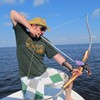 While my illustrious co-blogger has taken over running the Donor’s Choose challenge for Southern Fried Science this year, I decided to take up a single, worthy project to focus on. One of the challenges with Donor’s Choose is that it’s hard to fund the most expensive projects. People like to see the results of their donations, and funding a project to completion is extremely gratifying. From our experience over the last few years, most donations coming from our readership are small, so the project in the $200 to $500 range reap the bulk of the donations. This is great, but there are some big budget proposals on Donor’s Choose that are worthy of funding, too.
While my illustrious co-blogger has taken over running the Donor’s Choose challenge for Southern Fried Science this year, I decided to take up a single, worthy project to focus on. One of the challenges with Donor’s Choose is that it’s hard to fund the most expensive projects. People like to see the results of their donations, and funding a project to completion is extremely gratifying. From our experience over the last few years, most donations coming from our readership are small, so the project in the $200 to $500 range reap the bulk of the donations. This is great, but there are some big budget proposals on Donor’s Choose that are worthy of funding, too.
Which brings me to the title of this post: What if you’ve never seen the ocean?
Sometimes it’s not enough to set up aquaria, provide books, or design in-class experiments. In addition to all of that, students need to actually experience the ocean, which is exactly what In Search of Marine Diversity plans to do. From the project page:
Our students have great difficulty understanding ocean concepts because they have never visited an ocean beach.
This project will provide opportunities for them to get answers to their questions when they visit the Center for Marine and Education Research in Gulfport, Mississippi, to participate in relevant, hands-on learning at a three-day Sea Camp conducted by the University of Mississippi in coordination with CMERS.
Our school is a small rural public school in Arkansas. Much of the school district lies in a remote mountain range far from cities or major bodies of water (ocean). Students who ride the bus to school from this remote area are on the bus over three hours every school day (90 minutes each way). Our school had approximately 78 percent of the students receiving free or reduced lunches during 2011-12, so this year all students receive meals at no charge. Many families receive income from farming (cattle, chickens or timber) or from farming-related occupations. According to the 2010 census, the per capita income was $14,710 with only 52.3 percent of the population employed. This project is needed to provide opportunities for student learning that cannot be met in the classroom. The Gulf Coast studies includes snorkeling underwater adventures, a fossil dig, and hands-on exploration of freshwater turtles, horseshoe crabs, sea stars, sting rays, blue crabs, sea urchins, dolphins, etc.
This is an expensive trip. In order to send 20 students to University of Mississippi Sea Camp, the teacher is asking for almost $14,000, half of which is being met by the Walt Disney Company. Although this project launched almost a month ago, they have yet to receive a donation.
So, while my co-blogger manages the larger Donor’s Choose Project for SFS, I’m making it my personal mission to get this project funded.
Because no one should grow up without a chance to see the ocean.
I am torn about this one. One the one hand, I agree, sending kids to the ocean is a great thing (duh). On the other hand – and this is going to make me sound REALLY mean – this is an enormous, one-time expenditure for 20 kids. It is something that cannot be enjoyed by any additional kids. The $500 aquarium will be used by hundreds of kids, hopefully for man years – wouldn’t it be better to buy more classrooms smaller things, to enrich a lot of kids’ educations by a little bit?
I don’t think it’s a zero-sum gain. The smaller projects are getting funding, but wouldn’t it be great to do get a few bigger ones off the ground, too?
I guess I do think it’s a bit of a zero-sum game. People can only give so much money, and may want to use it for the maximum number of students. I know that’s why I donated to an aquarium project instead of to this project.
And I think that’s a perfectly valid decision that many donors are clearly making. But, for this drive, I personally want to focus on a project that has massive depth.
I like the fact that more people have donated than have commented!
Sending kids to the beach is a very good thing. I hope they’ll have on-their-own play time there, too, not just structured teaching time.
Visiting a beach by the ocean is lots of fun, and it’s informative in ways that can’t be measured. It’s worth every penny spent; these kids will benefit in ways that will stay with them all their life.
I can’t imagine life without knowing the smell of the sea, the sound of waves thundering against a beach, the smell, feel and sight of stuff in tide pools, stuff washed up, stuff eroding from cliffs – pale words for astonishing things.